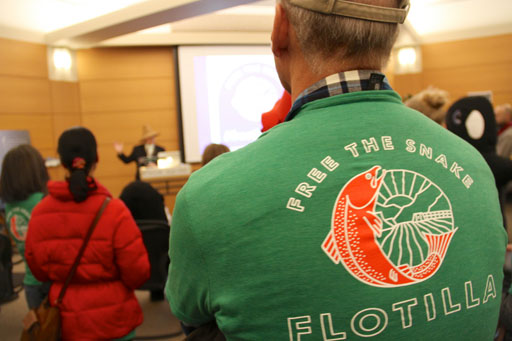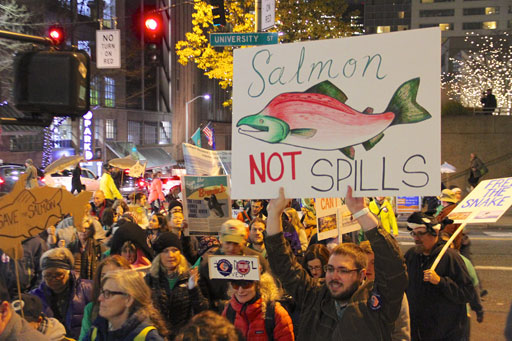Massive Public Response on Plans for Columbia River Basin Dams: Sierra Club Members Make their Position Clear
By Bill Arthur, Chair, Columbia-Snake River Salmon Recovery Campaign
Sierra Club members spoke loud and clear to the question of what should be included in the Environmental Impact Statement (EIS) for the court ordered revision to the federal agency salmon plan. The comment period, of January 17 reported in the Winter issue of the Crest got extended to February 7 allowing us to generate even more comments.
Scoping Comments
The Speak Up for Salmon educational campaign providing information about the salmon, dam removal issues, and the EIS process was very successful due to the strong engagement of Sierra Club members and other activists - THANK YOU!. The campaign, by Sierra Club and partners, resulted in approximately 400,000 individual citizen comments. Nearly 36,000 of those were from Sierra Club members.
We had strong turnout at the agency public meetings, and the pre-rallies done by salmon advocacy groups in December. Sierra Club generated half or more of the turnout for Seattle (over 350 total); the total turnout in Spokane was about 150, and in Lewiston/Clarkston also about 150.

A Strong Message
In addition to the individual comments, scores of entities submitted detailed responses. A clear and cohesive message about the value of removing dams to save salmon was submitted by a wide range of groups including Sierra Club. Bill Arthur, on behalf of Sierra Club, stated: “The district court in its summary judgment specifically encouraged consideration of dam removal on the Lower Snake Rivers as a reasonable alternative in the EIS. We very much agree and believe the EIS must include a full, fair, and thorough evaluation of bypass or removal of the four Lower Snake River dams as one of the reasonable alternatives”.
The U.S. Environmental Protection Agency said, “Of key importance in this context is the role of salmon as a provisioning species.” Furthermore, the EPA said, “We recommend that one of the alternatives consider the breaching or removal of all four dams on the lower Snake River coupled with cold water releases from Dworshak Reservoir.”
The Nez Perce Tribe pointed out that, “As NOAA Fisheries has previously acknowledged, ‘breaching the four lower Snake River dams would provide more certainty of long-term survival and recovery [of Snake River ESA-listed fish] than would other measures.’ The four lower Snake River dams do not provide flood protection and do not provide any meaningful amount of irrigation. These dams produce relatively little regional power.” The Northwest Energy Coalition concurred, saying “the LSR dams do not provide optimal economic value to the electric power system given their electric output capabilities and limitations.”
The Columbia River Inter-Tribal Fish Commission stated that,“These fish have been an important part of the economies of the region for thousands of years from the ancient Indian trade routes to modern commercial fishing.”
Many other fisheries, tribal groups and government groups also provided good input.
The State of Washington provided thoughtful comments and also recommended that alternatives should include, “Breach/remove one or more of the lower Snake River dams – compare the impacts of removing one or two of these dams with removing all four.” And, the Orca Salmon Alliance asked that the science showing importance of Snake River salmon and our Puget Sound Orca population be carefully evaluated along with dam removal.

Thank you to all the Sierra Club members who responded to our action alerts or attended one of the public meetings or pre-rallies hosted by salmon activists. Your effort will help assure a good EIS process going forward. We will continue to engage with the federal agencies and the state of Washington to assure a strong EIS and to achieve interim actions that can benefit salmon recovery.
While the official comment period is over there will be ongoing conversations with the agencies and public officials and stakeholder groups. It is helpful to continue to communicate with Senator Murray, Cantwell, and Governor Inslee to urge them to make sure the federal agencies follow-through with a full, fair, analysis of removing the lower Snake River dams to assure salmon recovery.
We will continue to provide updates and current information on the Washington Chapter website.
For further information contact Bill Arthur: billwarthur@gmail.com